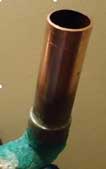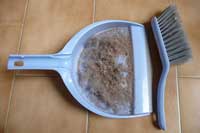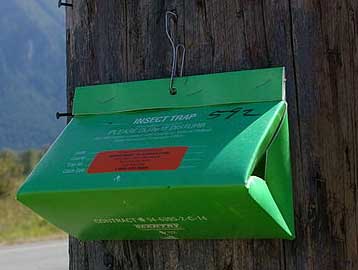The severe weather created by Hurricane Sandy left many homes damaged from the storms and depending on where people were living, many experienced fairly bad flooding. One effect from the storm damage, and especially the severe flooding, is the increase of pests and other unwanted wild animals in and around homes. The main thing to remember is that insects and small animals need shelter just like the rest of us. When it floods and their habitats are destroyed, they will naturally seek out shelter to protect themselves from the elements. Unfortunately, the shelter they will try to find could be your home.
There are many things you can do to reduce or completely eliminate unwanted pests from entering your home. While many of these methods may seem like common sense (such as cleaning your home), it’s still very important to do them if you want to take preventative action against insect infestations. Let’s look at a few DIY things that you can do around your home to help with pest control after any sort of natural disaster.
Take A Proactive Stance To Control Insects
The very first step in any sort of pest control scenario, is to identify the types of bugs you are dealing with. Some common insects that tend to try and seek shelter in your home after flooding are ants, roaches, spiders and scorpions. Of course, there are others but the good news is that the following steps can be applied to any sort of pest that is a potential threat to your home. Please make sure that you follow each step carefully to ensure that you are protected.
Step 1: Chemical Barriers
Many home improvement stores will sell a residential grade insecticide that can protect the outside of your home from insects that are trying to get inside. The chemical will absorb into the exoskeleton of the insect as they crawl over this invisible barrier. Although these products may not be as strong as a professional grade insecticide used by professional exterminators, they can go a long way to keep pests under control while you either take further preventive measures or until can get your home professionally done by a registered exterminator. The good news is that these chemicals can easily be applied without any sort of prior experience with pest control as there are usually easy to follow directions on the back. They are also usually rather affordable which make this a great DIY option for those that want to protect themselves without burning a hole in their pocket.
Step 2: Various Non-Insecticide Approaches
Remember, if you are worried about using chemical insecticides around your family, then there are some things you can try instead of spraying chemicals. First, take some time and effort to clean up any sort of food that may attract insects (such as ants) into your home. Based on my experience, I often find that crumbs and other bits of food often fall behind stoves and under fridges, especially if you have children. Ensure that surfaces are always wiped properly and clean up spilt juice and other forms of liquid quickly to ensure that insects are not attracted to the often sugary substance.
I highly recommend that you (and your family if applicable) make a habit of taking the rubbish out on a regular basis. I have found that many pest problems, even under normal circumstances (not during a natural disaster) are because of old food being kept inside the home because the bin has not been emptied for quite some time. Next, pull out your trusty vacuum cleaner and use it to clean up all the areas of your home, especially if you find things like spider webs and other signs of a bug infestation.
Remember that clutter around the house only encourages insects (like spiders) to take up residence as they feel protected and isolated in amongst all the junk. After a natural disaster such as hurricane Sandy, it’s especially important to take every effort to get your things back into an orderly fashion and if they never were in the first place, this is a great time to start from fresh!
Step 3 – Dealing With Moisture And Leaks
 Insects love moisture. Spiders, in particular, like to set up this webs in areas where there is a lot of moisture because they know it will attract other insects which end up being their next meal. The smallest amount of moisture can sustain a colony of ants for a long period of time. One major area of concern is the basement. Even without flooding, this area is usually the main culprit for areas of high moisture. I have found that insects will often make their first homes in the basement and then make their way upstairs for food and other things that they need to survive, which can often cause a major upset in the home, especially if you have a phobia for nasty bugs. The solution? Make sure that high moisture areas are well ventilated to prevent the build-up of moisture. Of course, after hurricane Sandy, your primary concern will probably be to drain all the water out your home. But once the majority of it has been removed, you can use heat and good ventilation to speed up the drying out process. Other water damage to your home may have caused by leaks in cracked and broken pipes. These will need to be fixed first before you can begin drying out your home.
Insects love moisture. Spiders, in particular, like to set up this webs in areas where there is a lot of moisture because they know it will attract other insects which end up being their next meal. The smallest amount of moisture can sustain a colony of ants for a long period of time. One major area of concern is the basement. Even without flooding, this area is usually the main culprit for areas of high moisture. I have found that insects will often make their first homes in the basement and then make their way upstairs for food and other things that they need to survive, which can often cause a major upset in the home, especially if you have a phobia for nasty bugs. The solution? Make sure that high moisture areas are well ventilated to prevent the build-up of moisture. Of course, after hurricane Sandy, your primary concern will probably be to drain all the water out your home. But once the majority of it has been removed, you can use heat and good ventilation to speed up the drying out process. Other water damage to your home may have caused by leaks in cracked and broken pipes. These will need to be fixed first before you can begin drying out your home.
Dealing With The Bigger Pests
Insects aren’t the only things that need to be considered during a natural disaster. When flooding occurs, the rising waters force small, wild animals such as raccoons, squirrels, possums and snakes to seek higher ground in order to survive. Unfortunately, this often means that they find their way into your homes and into your living areas which is both an inconvenience and a potential danger! While this blog is primary about insects, let’s take a brief look at how to prevent these creatures from getting inside during these times of distress.
Step 1 – Covering Entrances
Small animals will try enter your home through any space that is big enough for them to fit. This has been a major problem during hurricane Sandy because the strong winds often cause structural damage which they use to get inside. It’s important to act quickly! Spend some time looking for these breakages and either fix them immediately or cover these points of entry using any suitable materials until such a time that they can be repaired. Don’t forget to check your roof for any holes that may have been created by the strong winds and if you find any, make an effect to fix them as soon as possible. If you have any broken windows, I have found that using a plastic packet (that has been opened up to cover a large surface area) can keep both pests and the wind out when attached securely. Of course, this would not be a permanent solution but definitely a good one until it can be fixed properly. If you find any small holes, using a foam sealant works well and is very affordable. Sealing up any small holes will ensure that you are safe from the smaller pests such as rats and snakes that can squeeze through very small areas to find shelter and safety from harsh weather.
Step 2 – Making Use Of Traps
Unfortunately, sometimes you are either too late to proactively keep pests out of your home or there was already an insect problem that hadn’t been properly dealt with in the past. Either way, using an insect trap (such as flea traps or fruit fly traps) is a great way to catch and remove them from your living areas. There are a variety of homemade traps that you can make yourself at very little cost. Some can even be found on The Bug Squad and I highly recommend taking some time to review them. Another option is buying them at your local supermarket or ASPCA. Simply place the traps in areas of concern and check them from time to time for any results. Remember that you may need to reset them or clean up after they catch their victim so make sure you make yourself available for that.
Step 3 – “Your Pets” Versus “The Pests”
At first, I simply included this step to provide a bit of a laugh but after some consideration and some practical application, I have actually found it to be very useful to put your pets to work for you. For example, having cats around will help eliminate or at least reduce your rodent and snake problem. Just having the presence of a dog could also prevent other critters such as raccoons, possums and squirrels from wanting to come near your property. Pets can actually provide a natural way for you to control your pest problem without needing traps or having to use chemicals. While I don’t suggest purchasing or adopting a pet for this sole reason, the reality is that they are very helpful when it comes controlling pests around your home so put them to work, perhaps they can even save you some money and “earn” that really expensive pet food that you love giving them each day.
In conclusion, these steps are some of the many things you can do yourself to control your pest problem when you have had the unfortunate experience of having storm or flood damage. However, sometimes your pest problem may might be too much for you to handle yourself. In these cases, seeking the help of a professional exterminator is highly recommended. Remember, as previously mentioned, some of the pests can be potentially dangerous to you and your family and while I understand that your budget may be tight, their safety needs to be of high concern. In fact, some statistics show that it may even cost you more in the long run if you ignore your pest problem, hoping that it will just go away by itself. If you have a major problem, I highly recommend contacting a professional pest control company to assist you. I hope that this article has been beneficial! 🙂
Hello! My name is Natasha, and I have been helping people with their insect problems since 2012. I have published a book, worked with many pest control companies, and helped thousands with various infestations on a one-to-one basis. My goal for this blog is to create evidence-based guides that are easy to understand, provide sufficient depth and can be trusted to be very accurate. Please remember that my guides are for informational purposes only, and that you agree to the terms of use when reading content on this website. If you leave a comment, I typically respond within 48 hours.






The best way to control the population of pests is to cover all the areas where water is collected. Pest control all the areas which are moistened with the water as these are the places where pests love to stay.
Hey Miles! Thanks for your suggestion, I am sure that my readers will benefit from it 🙂 Water is often problematic when it comes to pest control due to potential bacteria buildup and your proactive approach is a good one.
Since bacteria is also a major problem in flooded areas, you will also need to remember to use a mask, sturdy gloves and safety glasses while cleaning your property and belongings as the flood water can be contaminated. Moreover you should clean your hands thoroughly after getting in touch with flood water.
Hey Smith! That’s very true and in fact, this bacteria can also attract more pests that thrive on it so things can escalate quickly. Thanks for sharing that information, its appreciated and I am sure that others will benefit from it as well!